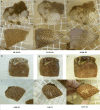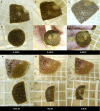Progressive chronic tissue loss disease in Siderastrea siderea on Florida's coral reef
- PMID: 40768407
- PMCID: PMC12327659
- DOI: 10.1371/journal.pone.0329911
Progressive chronic tissue loss disease in Siderastrea siderea on Florida's coral reef
Abstract
Stony coral tissue loss disease (SCTLD) has devastated numerous species of corals across the Western Atlantic but one reef coral, Siderastrea siderea, displays unusual tissue loss lesions. We examined the dynamics of lesions in S. siderea from the cellular to the ecological level and compared the disease with SCTLD in other coral species. We tagged and monitored six S. siderea colonies with bleached lesions in Fort Lauderdale and 17 S. siderea colonies with purple lesions in the Florida Keys for 18 months. Lesions on most colonies showed progressive tissue loss with an average change in healthy tissue of +5.5% in Fort Lauderdale (some bleached lesions resolved) and -51.1% in the Florida Keys. Case fatality rate was zero for colonies within Fort Lauderdale and 5.9% for colonies in the Florida Keys. The disease remained on S. siderea throughout the study in the Florida Keys but fluctuated through time in Fort Lauderdale. Lesion morphologies and disease pathogenesis differed between regions which could be due to different disease agents, environmental co-factors, intrinsic differences among colonies or different stages of the same disease. S. siderea is known to be a species complex which might also explain differences in lesion morphologies and disease pathogenesis. Aquaria studies found S. siderea with lesions transmitted disease to S. siderea and Orbicella faveolata and that S. siderea was also susceptible to SCTLD. Unlike SCTLD in other species, treatment with antibiotics did not stop lesion progression in S. siderea. Histology on lesions indicated a disease process regardless of lesion morphology and was consistent with SCTLD. We cannot completely rule out SCTLD but based on the other components of disease pathogenesis (rate of tissue loss, lesion morphology, colony mortality, response to antibiotics) we conclude this could be a different disease, which we term Siderastrea sidera chronic tissue loss disease, consistent with accepted disease nomenclature.
Copyright: © 2025 Aeby et al. This is an open access article distributed under the terms of the Creative Commons Attribution License, which permits unrestricted use, distribution, and reproduction in any medium, provided the original author and source are credited.
Conflict of interest statement
The authors have declared that no competing interests exist.
Figures











References
-
- Eakin CM, Sweatman HPA, Brainard RE. The 2014–2017 global-scale coral bleaching event: insights and impacts. Coral Reefs. 2019;38:539–45.
-
- Papke E, Carreiro A, Dennison C, Deutsch JM, Isma LM, Meiling SS, et al. Stony coral tissue loss disease: a review of emergence, impacts, etiology, diagnostics, and intervention. Front Mar Sci. 2024;10:1321271.
MeSH terms
LinkOut - more resources
Full Text Sources

